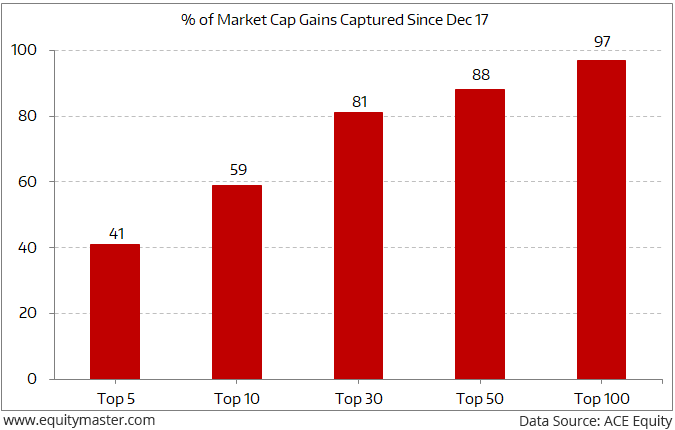- Home
- Todays Market
- Indian Stock Market News February 14, 2020
Sensex Opens Strong; Capital Goods and Telecom Stocks Lead Fri, 14 Feb 09:30 am
Asian stock markets are higher today as Japanese and Hong Kong shares show gains. The Nikkei 225 is up 0.5% while the Hang Seng is up 0.7%. The Shanghai Composite is trading up by 0.6%. Wall Street lost ground on Thursday, backing away from record highs as investors digested new coronavirus developments and mixed corporate earnings.
Back home, India share markets opened on a strong note. The BSE Sensex is trading up by 217 points while the NSE Nifty is trading up by 65 points. The BSE Mid Cap index opened up by 0.3% while BSE Small Cap index opened up by 0.4%.
All sectoral indices have opened the day on a positive note with telecom stocks and capital goods stocks witnessing maximum buying interest.
Speaking of the Indian share markets, note that Indian indices have witnessed a starkly polarised situation since 2018, after the uninterrupted bull rally of 2017 entered a period of correction.
While the Sensex recovered from the correction and went on to hitting new life-time highs, the broader markets - predominantly the small and midcap stocks haven't recovered much.
Ankit Shah, the editor of daily premium newsletter Equitymaster Insider (requires subscription), has been talking about this trend since a long time. But now, he has even more elaborate data to show you how deep this trend has been.
He pulled out data on 1,638 companies listed on the NSE.
And he shares his observations in a recent edition of The 5 Minute WrapUp...
- Between 29 December 2017 and 30 December 2019, just 246 companies have witnessed gains. Together, these 246 companies added Rs 29.8 trillion worth of market capitalisation.
In other words, 1,392 companies are below the levels they traded at the end of December 2017. Together, these 1,392 companies lost Rs 28.6 trillion worth of market capitalisation.
So, you see the money has literally shifted from one place to another.
Even among the 246 companies that witnessed gains, the major chunk was captured by just a small list of companies.
This can be seen from the chart below...
A Very Small Group of Stocks Captured All the Gains
As you can see, the top 5 companies captured 41% of all the gains in market capitalisation over the last two years. In fact, the top 30 stocks captured more than 80% of the gains.
In short, money has been rushing to safety, into large, liquid, bluechips stocks.
This brings the question: Where can you look for such bluechip stocks?
You can consider the bluechip recommendations made by our Safe Stocks guru, Tanushree Banerjee. She has picked her top 7 stocks for 2020.
Moving on, the rupee is currently trading at 71.32 against the US$.
The rupee on Thursday settled flat at 71.33 against the US dollar after weak macro-economic data disappointed market participants.
Reportedly, disappointing macroeconomic numbers and weak domestic equities weighed on the local unit, while easing crude oil prices and weakening of the American currency in the overseas market restricted the fall to some extent.
At the interbank foreign exchange market, the rupee opened at 71.35, then lost further ground to touch a low of 71.49.
The domestic unit finally settled at 71.33 against the US dollar, unchanged from its previous close.
Speaking of currencies, Vijay Bhambwani, editor of Weekly Cash Alerts, tells you the main reasons why not to trade commodities and currencies the same way you would trade equities. Here's an excerpt of what he wrote...
- Currencies are traded in pairs and the most liquid is the USDINR. Currencies are traded in four decimal points just as bonds are. The international derivative trader's association has indicated that forex may be traded in 6 decimals in the coming few years.
It takes months sometimes for the currency pair to pass the next round figure, say from 70 to 71.
Can you really trade commodities and currencies alike or for that matter, equities and currencies alike? Definitely not!
To know more, you can read Vijay's entire article here: Is Trading in Equities, Commodities, and Currencies the Same?
In another development, foreign investors turned net buyers in the Indian markets in the December quarter, pumping in a staggering US$6.3 billion on the back of the government's intent to bring reforms for supporting the economic growth.
This comes following a net outflow of US$3.2 billion by foreign portfolio investors (FPIs) in the quarter ended September 2019.
Reportedly, foreign investors started the quarter on a subdued note as they turned risk-averse with fears of a global recession and trade wars gaining momentum.
To know what's moving the Indian stock markets today, check out the most recent share market updates here.
For information on how to pick stocks that have the potential to deliver big returns, download our special report now!
Read the latest Market Commentary



Equitymaster requests your view! Post a comment on "Sensex Opens Strong; Capital Goods and Telecom Stocks Lead". Click here!
Comments are moderated by Equitymaster, in accordance with the Terms of Use, and may not appear
on this article until they have been reviewed and deemed appropriate for posting.
In the meantime, you may want to share this article with your friends!